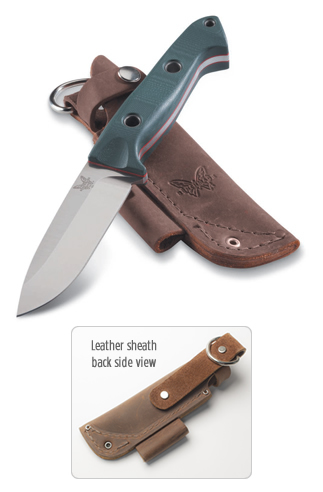Tips for Choosing Your Survival Knife
Posted by admin on Jan 6th 2013

If you walk into a room of knife enthusiasts and ask what is the best survival knife, you are certain to get as many answers as there are people in the room. The choice of a survival knife is very personal and has as much to do with the specific needs, strengths and preferences of the individual as it does the materials in the knife. There are several things to consider when choosing the best survival knife for you, because, regardless of which survival knife is best for you, there are certain characteristics that nearly every good survival knife shares in common.
Nearly every survival knife will be a fixed blade knife with a full tang. Fixed blade knives are generally beefier than their folding counterparts. With thicker blades and bigger handles that aren’t designed to be stuffed into a pocket, a survival knife is big enough and tough enough to handle cutting branches and small trees and then chopping these into pieces of firewood. A well-built survival knife can handle being banged on the spine with a heavy log or rock to chop through a thick piece of wood while most pocket knives would succumb to such abuse.
Also, fixed blade knives have no moving parts, which increases their strength and durability under harsh conditions. Along these lines, a full tang is almost an absolute necessity when choosing a survival knife. For some reason, there is a certain subset of “survival” guys that insist a hollow handle is the way to go–they like the storage compartment found in some so-called survival knives. Let’s put that idea to rest. A hollow spot is a weak spot. A weak spot is a future broken knife, and in a true survival situation, a broken knife spells catastrophe. I know the ESEE lovers are going to come out with their knives drawn because I said this–and I will admit, there are a few knives out there that seem to have figured out how to create a very strong skeletonized survival knife, put some scales on it for more comfortable use, and then use the spaces in the skeletonized handle for storage. But they are few and far between. And these knives aren’t necessarily what I am referring to anyway. I am talking about the “rambo”esque knives that have a hollow handle with a little compass on the butt. Those knives look neat, and definitely have their place. But they are not survival knives, no matter what Rambo says.
Your survival knife must have a good blade made of good steel. Choice of steel will vary. So will choice of blade shape. ESEE makes some great survival knives and they use 1095 steel for all of their blades. Benchmade just came out with their Bushcrafter knife and it has S30V. SOG uses AUS-8 for most of their military survival knives and Fallkniven uses laminated VG-10 in their extremely popular line of survival knives. Gerber uses 420HC in their best-selling LMF knives. And so you see, even the knife makers don’t agree. What you want is a knife that you can work with. For some people, S30V will be the best choice because they want a blade that will keep an edge for a long time–even though when sharpening time comes, it will be a bit more tough for them than for others. Other people will say, give me 1095 any day of the week for my survival knife, that way, if the knife gets dull when I am out in the wilderness, I can resharpen it in just a few minutes. Whichever knife steel you choose for your survival knife, just make sure you understand the properties of the steel and how to sharpen your knife.
Most survival knives have an extra thick blade so they can be used for heavy cutting and chopping. You should even be able to set the blade in a big chunk of wood and then bang on the spine of your blade with a small piece of wood to help “chop” the wood. A blade that is 1/4″ thick is not uncommon in the survival knife arena. How about length? Most survival knife blades run from about 4 inches all the way up to 6 inches long, although there are many that are even longer than that and some that are a bit shorter that do just fine. Once again, before you make your survival knife choice, make sure you understand what you are going to use your knife for. If you anticipate needing to chop a whole lot of wood, the ESEE Candiru is not going to be a good choice for you. But if you need a utility survival knife that can get you through some rough spots and doesn’t take up much storage room in your gear bag, then the Candiru could very well be the very best choice for you.
A good full tang, fixed blade knife should also have a pommel that can handle being banged on. While you are banging on the pommel, let your eyes wander over to the handle. A great survival knife will have a handle that is comfortable in your hand. It will also allow you to get a good, solid grip and keep that in inclement weather and conditions. Here is where a whole lot of the debate arises as to which survival knife is best. Everyone has different size hands. What may feel great in my hand, could feel terrible in yours. Just because your buddy has a knife that he insists is the end all, be all survival knife, which it may well be for him, but it doesn’t mean it will be for you also. Consider the material used for your knife handle. Micarta and G-10 are common choices because they have good weight to strength ratios and are durable enough to handle heavy use.
Most good survival knives will have a lanyard hole at the butt end so you can tie a lanyard on your knife and then slide the lanyard over your wrist for extra security. That way, if on a particularly hard chop, you lose the grip on your knife, it isn’t going to fly off into the underbrush and be lost forever–leaving you in the wilderness without a tool.
Whichever survival knife you choose, remember to consider these points.
- Full tang
- Blade Steel
- Blade Thickness
- Blade Length
- Steel Type
- Handle Material
- Handle Shape
The choice of a survival knife is personal. If you are comfortable with your knife, you are going to get the production you need out of it. Make sure your survival knife is the very best there is. . . for you.

